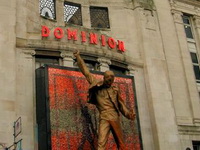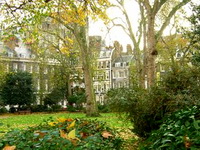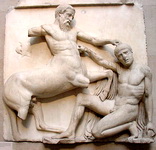Dave the Taxi Driver's
|
| |
|
Dave the Taxi Driver's | |
|
|
|
|
|
 |
 |
 |
Bloomsbury (WC1)
Academia, The British Museum and Charles DickensHanging in the air above Bloomsbury there seems to me to be a reminder that we need to take life more seriously, that we should not fill our time with frivolity and consumerism, but that we need to remember and reflect on the years passed, when the foundations of our society were being laid. Bloomsbury does not represent the present, but the epoch which made our modern world possible. When the intrepid explorers were expanding the boundaries of the British Empire, engineers were creating new wonders and academics were bursting their way into the new sciences. This new Victorian world was a revelation of success, but it was easy to ride on its crest and ignore its failures. The inequality and abject poverty on its own doorstep in London itself was reviled by intellectuals. No more so than Charles Dickens who lived at several addresses here, 48 Doughty Street is now the Dickens House Museum. Blemondisberi as it used to be known, like many villages, was first noted in the Domesday Book of 1086. It became Bloomsbury around the beginning of the 13th century as the manor of William de Blemond. It was an area of vineyards and farmland where pigs were reared. King Edward III acquired this land a couple of hundred years later and presented it to the Order of Carthusians who continued to farm the area for almost 150 years. Guess who spoilt it for them around 1536? Yes Henry VIII, the king who turned what would have been English history upside down, acquired the manor and kicked out the monks. He gave it to Thomas Wriothesley, the Earl of Southampton. Bloomsbury, although it sits just above Covent Garden and is a couple of minutes walk from Oxford Street has little in common with either, it is a place where you can take a breather. Although like anywhere in London it does have its hotels, restaurants, pubs and clubs. The Bloomsbury Theatre in Gordon Street is part of the University. More of the fringe element of entertainment takes place here, as you might expect (where we saw the great Iranian comedian Omid Djalili). The Dominion is on the corner of Tottenham Court Road and New Oxford Street, where Ben Elton’s Queen musical ‘We Will Rock You’ has been showing for years.
Bloomsbury though always been associated with learning and literature and as a result there are quite a few specialist and rare book shops. Almost half of Bloomsbury is taken up by the University of London(1836) and its associated colleges and departments, complemented by institutions such as the British Medical Association, the Wellcome Foundation, The Royal Academy of Dramatic Arts and The Swedenborg Society. The British Library used to be here but was relocated next door to St.Pancras International Station. Beauty is in the eye of the beholder of course, but the new British Library building has to be one of the worst looking places of learning in the world. Prince Charles remarked that it looked like a collection of sheds. But the library has left Bloomsbury so I shall not mention it any more, apart from the fact that it is just across the road from Judd Street and a fabulous place to visit, with original documents dating back hundreds of years.
There are also three particular churches that are worth a mention, especially if you are interested in church architecture: St. George’s Bloomsbury (Anglican) on Bloomsbury Way has a mix of styles which include a Roman Porch with large Corinthian Columns. The steeple is modelled on the Mausoleum at Halicarnassus which is topped with a statue of King George I depicted as a Roman. St. Pancras New Church (Anglican) has a portico of the Caryatids copied from the Temple of the Erectheum on the Acropolis in Athens. The imposing Church of Christ the King in Gordon Square is built in the neo-gothic style.
Augustus Welby Pugin was born in Bloomsbury. In case you haven’t heard of him, he was the architect responsible for the marvellous interiors of the Palace of Westminster when it was rebuilt after it had burned down in 1834. I recommend you take a tour of the Palace of Westminster. It is amazing inside.
Bloomsbury’s haunting black brick houses with their heavy iron railings and stone tread- worn steps, evoke memories of old, foggy gas lit Dickensian London, when horse and carriage rumbled through the cobbled streets. Bloomsbury is also noted for its beautiful garden squares. There are very informative, guided historical walks which detail their history. |
|
Queen Square (formerly Queen Anne Square) is home to the National Hospital for Neurology and Neurosurgery, the Royal National Homeopathic Hospital and The National Hospital. Just around the corner is the greatly respected Great Ormond Street Children’s Hospital. Queen Square also possesses a very small interesting pub, the Queen’s Larder. When King George III went mad, he was treated by a doctor in the square. Queen Charlotte, his wife, complemented his treatment by supplying him with special foods which she prepared from a cellar room she had rented in the pub. Tube: Russell Square; Euston Square; Goodge Street; Warren Street; Tottenham Court Road; Chancery Lane; Holborn; Euston (& National Rail)
Any questions? E-mail me |
|
|